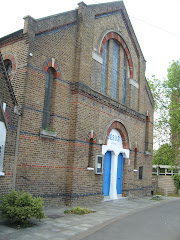Childs Hill. A district on both sides of the Hendon-Hampstead border, Childs Hill took its name from Richard le Child, who in 1312 held a customary house and 30 acres, probably on the Hendon side. A similar estate was held at the same time by Richard Blakett, who gave his name to Blacketts well, which in 1632 was one of the boundary markers in the area and in 1801-2 was disputed in ownership.
By the mid 18th century the Hampstead part of Childs Hill was divided in two by the road later called Platt's Lane, which ran from West End and Fortune Green to the heath, Hampstead town, and Hendon. It was entirely occupied by two estates, both of which may have originated as land of the Templars. A farmhouse on the edge of the heath in the north part of the larger estate had apparently become detached from the farmland before 1811, when it was enlarged by Thomas Platt as a 'pleasing and unostentatious' brick house set in well wooded grounds.
The arrival of the Finchley road lessened the area's isolation. A house called Temple Park was built on the smaller Temples estate probably in the 1830s by Henry Weech Burgess, a prosperous Lancastrian. About the same time farm buildings were erected on Platt's estate fronting Platt's Lane. In 1843, on the western portion of Childs Hill estate, T. Howard built Kidderpore Hall, a stuccoed Greek revival house with a slightly projecting colonnade, side pediments, and a semicircular bay, for John Teil, an East India merchant with tanneries in the district of Calcutta from which the house took its name. The grounds became a private park and two lodges were added, one on the Finchley road in 1849, the other on Platt's Lane in the late 1860s. On a field of Platt's estate which jutted westward south of Teil's estate, four houses fronting Finchley Road were built in the 1840s in the district called New West End.
By 1870 the farm buildings at Platt's Lane had been replaced by a house. Two cottages were built in Platt's Lane by P. Bell of West End in 1875 and 13 houses, mostly by George Pritchard, between 1884 and 1886.
From: 'Hampstead: Childs Hill', A History of the County of Middlesex: Volume 9: Hampstead, Paddington (1989), pp. 73-5. URL: here
From: 'Hampstead: Childs Hill', A History of the County of Middlesex: Volume 9: Hampstead, Paddington (1989), pp. 73-5. URL: here




